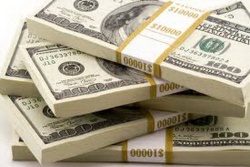Difference between revisions of "Money"
| (One intermediate revision by the same user not shown) | |||
| Line 1: | Line 1: | ||
[[File:Money.jpg|thumb|250px|]] | [[File:Money.jpg|thumb|250px|]] | ||
| − | + | [[Money]] ([[mūla]]) is tokens made out of metal, paper or plastic representing value and which can be exchanged for goods and services. A barter economy operated during the [[Buddha’s]] [[time]] and [[money]] was just starting to come into use. The most common coins were ''kahāpaṇa, nikkha, aḍḍhapāda'' and ''māsaka'' (A.I,250; M.II163; S.I,82). These names refer to the weight of the coin, the value of which depended on whether they were made out of {{Wiki|gold}}, {{Wiki|silver}}, {{Wiki|copper}} or an alloy. Māsaka were made only out of {{Wiki|copper}} and it took 15 to represent any significant value. Tokens made out of shells, [[seeds]], [[wood]] and lac were also used as a {{Wiki|medium}} of exchange (Vin.IV,238). All early [[Indian]] coins were square because it was easier to cut them out of sheets of metal rather than stamp them using a round [[die]]. | |
| − | The Buddha forbade monks and nuns from even touching gold and silver and they were not allowed to engage in barter either (A.II,53), although very few Buddhist monks or nuns continue to follow this rule today. Lay people practising the ten Precepts on certain days will also not use gold, silver or money either. However, the Buddha was aware that money can help us to satisfy our desires, give a sense of security and even win the respect of others, and, therefore, it can be a means of happiness. Thus, he considered the pursuit of wealth to be a worthwhile and legitimate goal for lay people, the proviso being, of course, that it is ‘earned by hard work, by strength of arm and sweat of brow, lawfully and fairly’ (A.II,67). He recommended that prudent people should balance their expenditure with their income (A.IV,281) and divide their money into four and use it for: (1) basic needs, (2) miscellaneous expenses, (3) charity and (4) be put aside for future eventualities (A.III,46). See Interest. | + | The [[Buddha]] forbade [[monks and nuns]] from even [[touching]] {{Wiki|gold}} and {{Wiki|silver}} and they were not allowed to engage in barter either (A.II,53), although very few [[Buddhist]] [[monks]] or [[nuns]] continue to follow this rule today. [[Lay people]] practising the [[ten Precepts]] on certain days will also not use {{Wiki|gold}}, {{Wiki|silver}} or [[money]] either. However, the [[Buddha]] was {{Wiki|aware}} that [[money]] can help us to satisfy our [[desires]], give a [[sense]] of {{Wiki|security}} and even win the [[respect]] of others, and, therefore, it can be a means of [[happiness]]. Thus, he considered the pursuit of [[wealth]] to be a worthwhile and legitimate goal for [[lay people]], the proviso being, of course, that it is ‘earned by hard work, by strength of arm and {{Wiki|sweat}} of brow, lawfully and fairly’ (A.II,67). He recommended that prudent [[people]] should [[balance]] their expenditure with their income (A.IV,281) and divide their [[money]] into four and use it for: (1) basic needs, (2) miscellaneous expenses, (3) [[charity]] and (4) be put aside for {{Wiki|future}} eventualities (A.III,46). See [[Interest]]. |
{{R}} | {{R}} | ||
[http://www.buddhisma2z.com/content.php?id=272 www.buddhisma2z.com] | [http://www.buddhisma2z.com/content.php?id=272 www.buddhisma2z.com] | ||
[[Category:Buddhist Terms]] | [[Category:Buddhist Terms]] | ||
Latest revision as of 16:19, 4 February 2014
Money (mūla) is tokens made out of metal, paper or plastic representing value and which can be exchanged for goods and services. A barter economy operated during the Buddha’s time and money was just starting to come into use. The most common coins were kahāpaṇa, nikkha, aḍḍhapāda and māsaka (A.I,250; M.II163; S.I,82). These names refer to the weight of the coin, the value of which depended on whether they were made out of gold, silver, copper or an alloy. Māsaka were made only out of copper and it took 15 to represent any significant value. Tokens made out of shells, seeds, wood and lac were also used as a medium of exchange (Vin.IV,238). All early Indian coins were square because it was easier to cut them out of sheets of metal rather than stamp them using a round die.
The Buddha forbade monks and nuns from even touching gold and silver and they were not allowed to engage in barter either (A.II,53), although very few Buddhist monks or nuns continue to follow this rule today. Lay people practising the ten Precepts on certain days will also not use gold, silver or money either. However, the Buddha was aware that money can help us to satisfy our desires, give a sense of security and even win the respect of others, and, therefore, it can be a means of happiness. Thus, he considered the pursuit of wealth to be a worthwhile and legitimate goal for lay people, the proviso being, of course, that it is ‘earned by hard work, by strength of arm and sweat of brow, lawfully and fairly’ (A.II,67). He recommended that prudent people should balance their expenditure with their income (A.IV,281) and divide their money into four and use it for: (1) basic needs, (2) miscellaneous expenses, (3) charity and (4) be put aside for future eventualities (A.III,46). See Interest.
